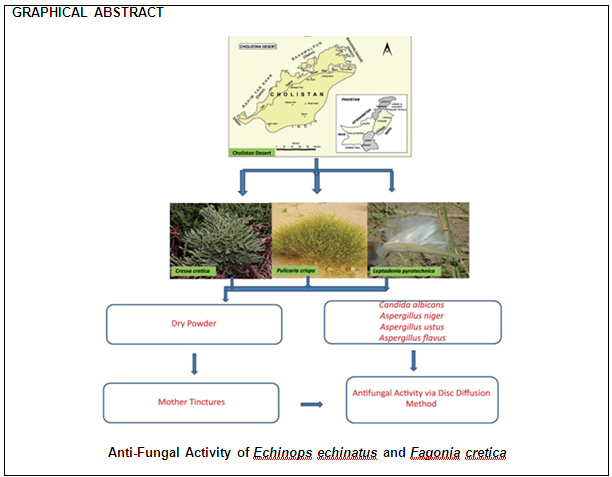Antifungal Activity of Echinops echinatus and Fagonia cretica from Cholistan Desert-Pakistan
Faheem Hadi *
Centre of Research in Molecular Medicine, Institute of Molecular Biology & Biotechnology, the University of Lahore, Lahore, Pakistan.
Annum Khawer
Rural Health Centre, Chung, Lahore, Pakistan.
Amna Riaz
Centre of Research in Molecular Medicine, Institute of Molecular Biology & Biotechnology, the University of Lahore, Lahore, Pakistan.
Anaab Basharat
Centre of Research in Molecular Medicine, Institute of Molecular Biology & Biotechnology, the University of Lahore, Lahore, Pakistan.
Muhammad Habib-E-Ajmi
Centre of Research in Molecular Medicine, Institute of Molecular Biology & Biotechnology, the University of Lahore, Lahore, Pakistan.
Tahir Maqbool *
Centre of Research in Molecular Medicine, Institute of Molecular Biology & Biotechnology, the University of Lahore, Lahore, Pakistan.
Muhammad Rafiq
Centre of Research in Molecular Medicine, Institute of Molecular Biology & Biotechnology, the University of Lahore, Lahore, Pakistan.
Muhammad Sarwar
Centre of Research in Molecular Medicine, Institute of Molecular Biology & Biotechnology, the University of Lahore, Lahore, Pakistan.
Tahir Muhammad
Centre of Research in Molecular Medicine, Institute of Molecular Biology & Biotechnology, the University of Lahore, Lahore, Pakistan.
Memoona Zahra
School of Pharmacy and Medical Sciences, Griffith University, Australia.
*Author to whom correspondence should be addressed.
Abstract
Background: Fungal infections are getting worse due to their resistance against available antibiotics and have always remain a problem. Homoeopathic mother tinctures are part of therapy in clinical patients with less side effects and much efficient against pathogenic infections.
Methodology: Echinops echinatus and Fagonia cretica plant mother tinctures were performed and used to evaluate the anti-fungal potential of these plants against potentially pathogenic fungal species like Candida albicans, Aspergillus ustus, Aspergillus niger and Aspergillus flavus by agar disc diffusion method. Three doses were used (0.25 ml, 0.5 ml and 1 ml volume per disc) and zone of inhibition was observed in millimetres and compared with positive control Fluconazole (2 mg/ml) which is commercially available.
Results: The results indicated efficacy of both mother tinctures showed remakarble activity against pathogens with zone of inhibition ranging 17.33 – 30.33 mm.
Conclusion: Current work indicated anti-infective potential of plants which can be added in therapy of infections in future after confirmation in in-vivo models.
Keywords: Antifungal activity, cholistan desert, homeopathic mother tincture, Echinops echinatus, Fagonia cretica

